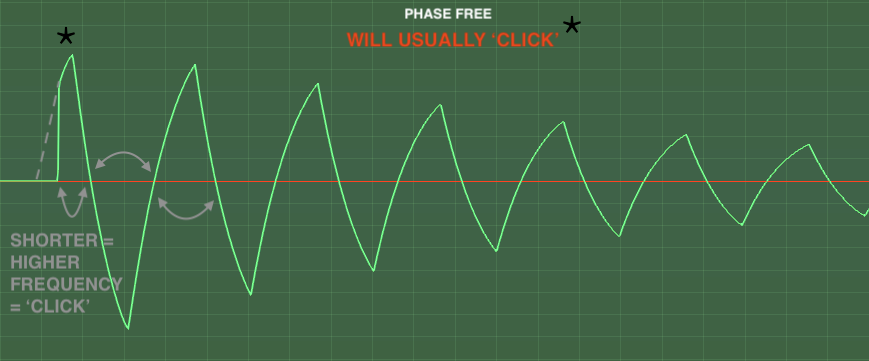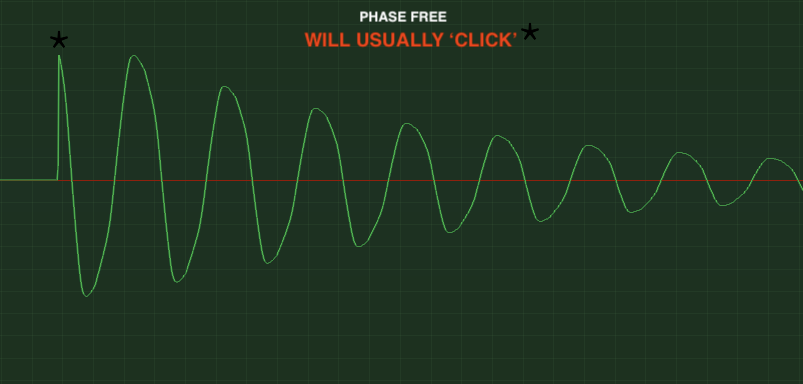Nothing’s leaking anywhere, it’s definitely not a bug, it’s the nature of what you are trying to do without accepting the simple realities as I’ve stated above and I’m pretty sure Elektron will advise that there’s nothing they can do (as that necessitates compromises, at best)
Here’s why it’s generally only ever discussed in the context of low frequency or simple fundamental waves … it’s because it’s just so much more obvious
You are triggering an envelope whilst the oscillator is currently sounding a low frequency wave, that existing wave can be at any position in its phase cycle, so it’s immediately reset to zero, this means a potentially massive change in the existing periodicity at the transition and the typical evidence of this is shown below, with and without oscillator reset for both the ‘saw’ and ‘sin’ - this is a single oscillator from the DVCO, no filter and amp fastest/longest i.e. fully open. Only adopting to use SYN decay to show it doesn’t change the reason clicks occur, it just avoids the issue by taking away the key ingredient, which won’t always be an agreeable compromise, especially for the DVCO or long kicks etc
The issue I was discussing above relating to the envelope profile is no different whether it’s the amp envelope or the internal ‘fade’ settable per oscillator
It’s all about what happens when the phase is arbitrarily reset in an instant, there will almost certainly be a very obvious change in the frequency content due to the truncated wave which is implicitly short relative to the interrupted content … shorter waves are higher frequencies and as it’s always less than a cycle and probably between two lower frequency ‘neighbours’ it is conspicuous too - this is just not as noticeable with higher frequency ‘busy’ content, but it happens there too, you just notice it way less and as the content frequency is higher it can be that the ‘click’ interruption is of a similar frequency anyway
Further, slow AMP envelopes will NOT address this, as you are still going to abruptly cut the existing wave at an arbitrary phase point and therefore truncate a low frequency cycle into a higher frequency cycle
This is why there is a so called ‘analog’ envelope option which does not reset the amp envelope, so the envelope builds from where it is, this can result in less severe interruptions as the volume profile isn’t being as radically transformed and may be less conspicuous irrespective of any oscillator phase reset
I’m discussing this in detail because my points are missed and it helped when doing this for OT transitions when streaming from card or ram at loop points, it’s the same basic physics - you’re interrupting a wave and implicitly truncating it in some way, therefore creating high frequency blips
The reason it is ‘inconsistent’ is because the phase is completely arbitrary when the oscillator is triggered (if not resetting) or retriggered (if not or even if resetting)
This isn’t a bug and the workaround is only making a difference because you kill the source sound, so there’s no wave to ‘interrupt’ - it obviously only works if oscillator reset is enabled, but it’s no use for the DVCO if you want sustaining notes (you don’t want any SYN decay) and it’s no use for notes close together as you still have the same basic fundamentals crashing the party - interrupted low frequency waves are going to click
Here are a few pictures which always help clarify the thoughts
There’s a set for DVCO ‘SAW’ and ‘SIN’ with Phase reset on and off and also where notes follow one another, in this case octave jumps up
There’s a clarification diagram at the end showing how the phase of the wave you interrupt is completely arbitrary and therefore introduces unavoidable clicking, the theoretical mitigations for this are unpalatable and this is why it’s just something (especially on an analog circuit) we just need to accept as the nature of the beast
This is one of those topics that people come back to time and time again, insisting it’s a bug without considering what is actually happening, I hope this post goes a little way to understanding why there is inconsistent clicking and when it’s most noticeable
SAW FREE
SAW PHASE RESET
SIN FREE
SIN PHASE RESET
PHASE ‘JUMP’ POSITION IS ARBITRARY : Existing waves will generally click
Consider the truncated (dashed triangle) wave-period ahead of the reset phase oscillator with ANY amp profile - you generally create a ‘higher frequency’ perturbation that will be more or less obvious depending on when the new note is requested … the lower the frequency either side of the transition, the more obvious, the interruption impact is arbitrary (thus inconsistent) and largely unavoidable
ANY AMP profile to the right of the trigger point, whether reset or not, will not change the fact that you have ALREADY forced a premature termination of a wave which is implicitly shorter and will be conspicuous in low frequency simple content. This is most evident with content which is tending towards being of a low with simple fundamental only nature, therefore the contrast of this ‘diverted’ wave is simply more obvious than it would be in almost any other circumstance.
A bug is unexpected behaviour, this is not a bug








